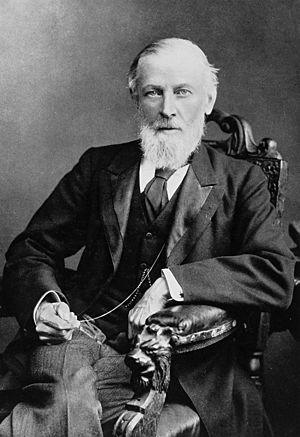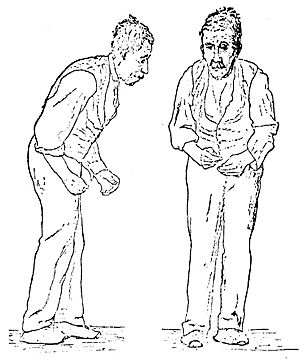William Gowers (neurologist) facts for kids
Quick facts for kids
Sir William Gowers
|
|
|---|---|
 |
|
| Born |
William Richard Gowers
20 March 1845 |
| Died | 4 May 1915 (aged 70) |
| Alma mater | University of London |
| Children | Ernest Gowers |
| Scientific career | |
| Fields | Neurology |
Sir William Richard Gowers (born March 20, 1845 – died May 4, 1915) was a very important British neurologist. A neurologist is a doctor who studies and treats problems with the brain and nervous system.
Many people, including other doctors, thought he was one of the greatest neurologists ever. He worked at a famous hospital in London called the National Hospital for the Paralysed and Epileptics. He also taught at University College Hospital. He wrote many books, but his most famous one was Manual of Diseases of the Nervous System. Doctors at his hospital even called it the Bible of Neurology because it was so important.
Contents
Early Life and School
William Richard Gowers was born in Hackney, London, in 1845. His father made ladies' boots. By the time William was 11, his father and all his brothers and sisters had sadly passed away. His mother moved to Doncaster, and William went to live with relatives in Oxford. There, he went to Christ Church school.
After school, he tried working on a farm in Yorkshire, but it wasn't a good fit for him. Later, he visited his aunt in Essex. She introduced him to a local doctor and suggested he become a medical apprentice. An apprentice learns a skill or job by working with an expert. William agreed, even though he wasn't sure at first. He spent three years learning from Dr. Thomas Simpson.
William's family had a background in a type of Protestant church called Congregationalism. Dr. Simpson also belonged to this church. At the time, many universities only allowed students from certain religious backgrounds. The University of London was different; it welcomed students from all backgrounds. William was encouraged to try and get into this university.
While he was an apprentice, he started keeping a diary in Pitman's shorthand. This was a special way of writing very quickly. He wanted to master this skill before going to university. With help from local church ministers, he studied hard. In 1863, he passed his university entrance exam with excellent results.
Career and Important Work
After passing his exams, William Gowers met a famous doctor named William Jenner. Dr. Jenner helped Gowers a lot and even hired him as his secretary. Gowers did very well at university. In 1870, he got a new job as a Medical Registrar at the National Hospital for the Paralysed and Epileptic in London. He worked there until 1910.
In 1875, he married Mary Baines. They had two sons and two daughters. His sons, William Frederick Gowers and Ernest Gowers, both had important careers in government. Ernest Gowers later became famous for writing a book called Plain Words, which helped people write more clearly.

Most of Gowers' most important books, including his two-volume Manual of Diseases of the Nervous System, were written between 1870 and 1890. This book is still used today by doctors as a key reference. He was excellent at figuring out what was wrong with his patients. His teaching at the hospital made him famous around the world. In 1887, he became a professor at University College London.
Gowers was also a talented artist and enjoyed etching pictures. He even had one of his etchings shown at a famous art exhibition, the Royal Academy.
Working so hard eventually affected his health. He passed away in 1915 when he was 70 years old. He had been given the title of "Sir" in 1897, which meant he was knighted for his important work.
How Gowers Did His Research
Gowers was one of the first doctors to collect a lot of information and facts about his patients. He used his own detailed patient records for his research, instead of just using information from other sources. Since there were no computers or recording devices back then, he used his shorthand skills to write down everything about his cases.
Later in his life, he even started a group called the Society of Medical Phonographers. This group was for doctors who used shorthand. He also created a shorthand journal for medical teaching. Some students made fun of him for loving shorthand so much, but it was a very useful skill for him throughout his life.
What Gowers Taught Us About Neurology
Medical journals like The Lancet and the British Medical Journal praised Gowers greatly. They said he was an amazing observer who was very accurate and careful. He had a wide view of things and made reliable conclusions from what he saw. They also said he was a remarkable teacher and helped expand the field of neuropathology (the study of nervous system diseases).
Gowers was also known for writing very clearly. This made his books and articles easy to understand. He also helped explain the ideas of another great doctor, Hughlings Jackson, to the medical world. Jackson's writings were often hard to understand, but Gowers made them clear.
Some medical terms and places are named after Gowers:
- Gowers' sign: This is a way to spot muscle weakness, especially in children.
- Gowers' tract: This is a specific pathway in the nervous system.
- Gowers' syndrome: This refers to a type of fainting spell.
- Gowers' Round: This is a weekly meeting at the National Hospital where doctors discuss patient cases and teach.
In 1892, Gowers helped start the National Society for the Employment of Epileptics. This group, now called the Epilepsy Society, helps people with epilepsy.

